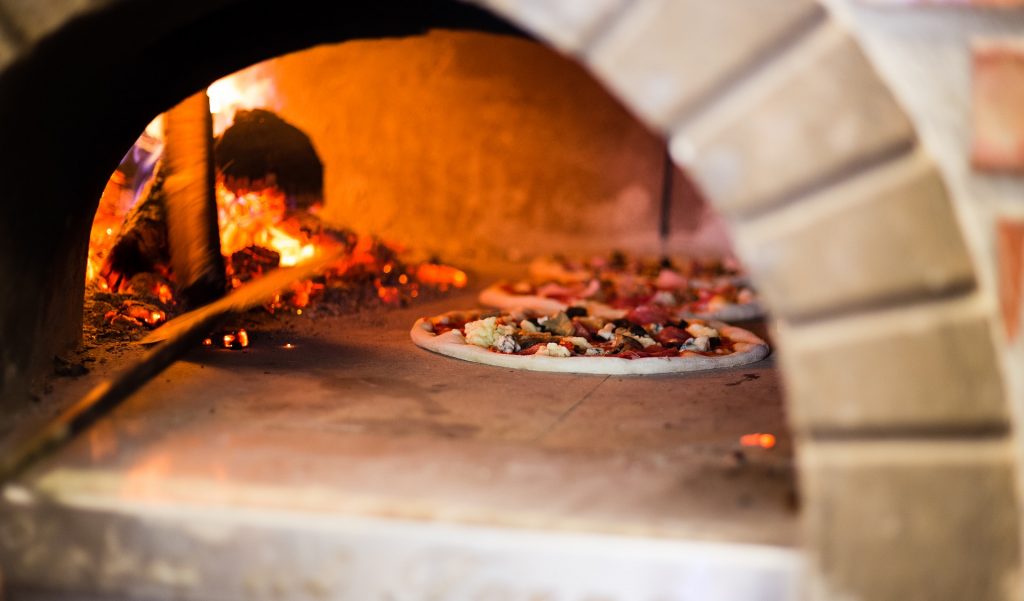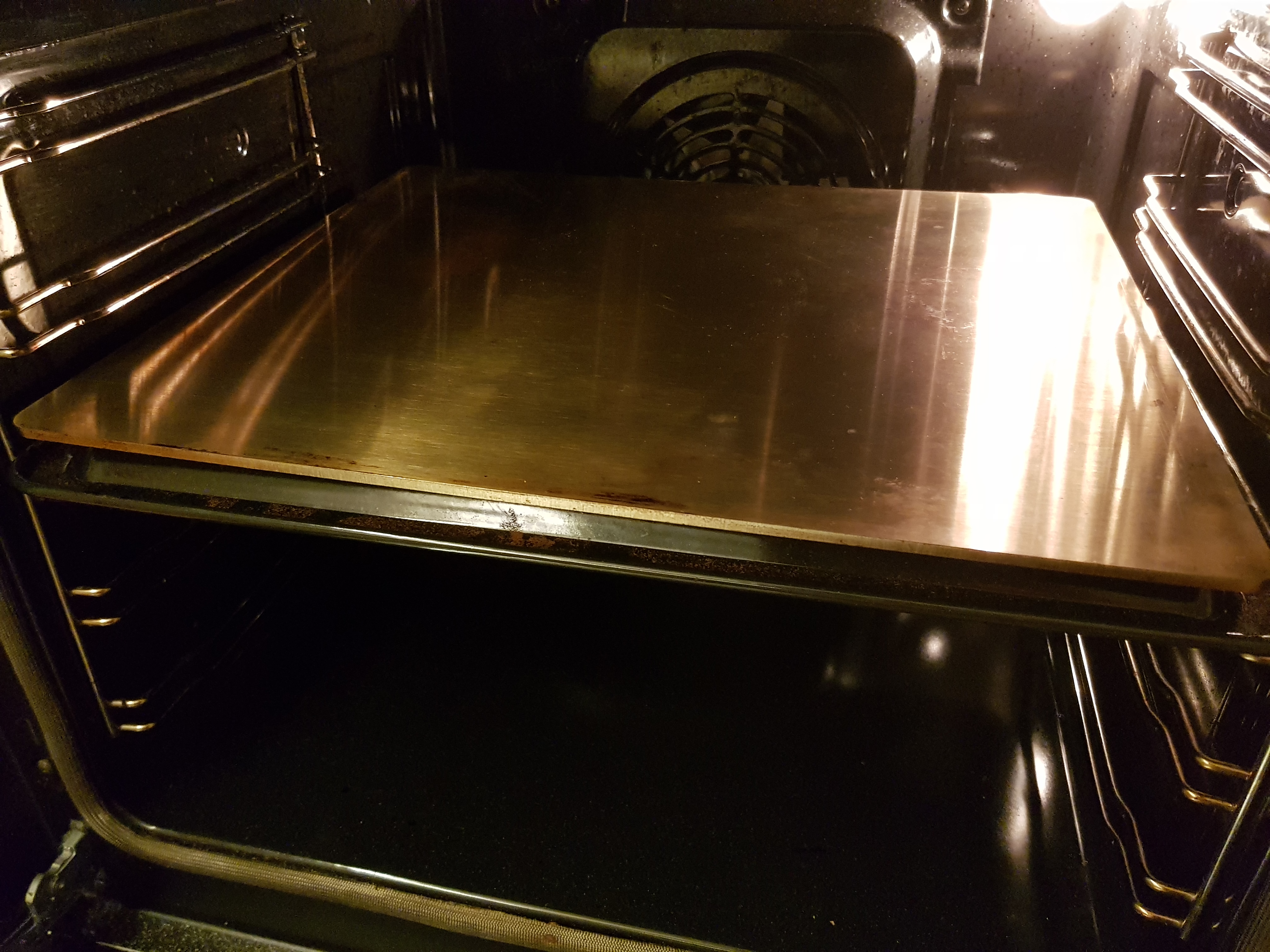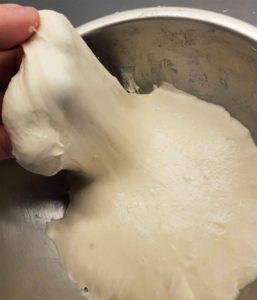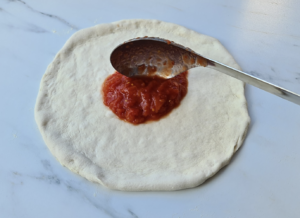Neapolitan pizza crust is different. It’s crispy and soft at the same time, and it’s also uniquely flavorful. But what makes this crust so different?
Neapolitan pizza crust is a raised, slightly charred crust with a crispy exterior, yet a soft and airy interior. The unique texture is created by baking the pizza quickly in a hot oven. This method of baking also creates the iconic leopard pattern on the crust. A slightly charred crust, combined with a long fermentation time creates a unique and flavorful crust only found on Neapolitan pizza.
What Is Neapolitan Pizza Crust?
Neapolitan pizza crust is tall, light, and airy. It’s crispy on the outside and covered in small, charred spots, called leaoparding (due to the leopard-like pattern). The crust also has an open and soft interior with large air bubbles. The flavor is often described as complex due to the long, slow fermentation of 24 hours or more.
You can’t talk about Neapolitan pizza without mentioning The True Neapolitan Pizza Association. The True Neapolitan Pizza Association, or AVPN, is an international organization that protects the pizza traditions of Naples. They’ve also defined an international standard for true Neapolitan pizza, where they describe what a Neapolitan pizza should be like, what ingredients should be used, and how to make it.
A Neapolitan pizza should be a round disk, and have a diameter of at most 13.5 inches (35 cm). The center should be flat and thin (0.1 inch or 2.5 mm), while the edge should be around 1/2 inch (1-2cm) tall.

To be able to make a pizza like this, you need the right type of dough. It has to be elastic and stretchy so the base of the pizza can be stretched nice and thin. The edge of the pizza needs to remain untouched to preserve the air bubbles from the fermentation process. It also needs to be baked in a hot, wood-fired oven.
What Makes Neapolitan Pizza Crust Unique?
Baking of the pizza in a wood-fired oven is part of the secret to the unique Neapolitan pizza crust. This is what makes the crust crispy on the outside, yet soft, light, and airy on the inside. The crust puffs up in the oven and creates large air bubbles inside the crust. The quick, hot bake is also what charrs the crust without drying out the interior. When you combine this with a slow-fermented dough you get a delicious flavor combination.
The dough needs a high gluten content to be able to stretch out thin and to allow large air bubbles to form inside the crust. The dough is elastic, stretchy, and pliable. This is due to the use of high-quality ingredients, proper hydration and kneading of the dough, and staying true to the recipe.
Baking Hot and Fast
The Neapolitan pizza crust is crispy and soft at the same time. This is unique, and something you only can achieve when you bake bread very fast at a high temperature. The hot temperature will crisp and char the crust, but the short time doesn’t give the dough enough time to dry out.

According to the AVPN, a Neapolitan pizza should be baked in a wood-fired oven at 905°F (485°C) for only 60-90 seconds. When you bake pizza at this temperature, the crust will puff up and create the tall, airy crust edge that you associate with Neapolitan pizza.
The baking of the pizza is a balance between the heat from the floor and the radiating heat from the ceiling of the wood-fired oven. You need a balance between the two to make sure both the top and the bottom of the pizza finish at the same time.
The high heat also chars the crust. It is however important to distinguish between burnt and charred because Neapolitan pizza crust should not be burnt, only have these slightly charred spots on the crust. The charring creates a slightly bitter flavor to the crust, that’s iconic of the Neapolitan pizza. In combination with the complex flavor of the slow-fermented dough, the sweetness and acidity of tomatoes and the creaminess of mozzarella cheese create an amazingly balanced flavor profile.
The Dough
A Neapolitan pizza should have a thin center and a raised edge (cornicione). To be able to stretch the dough so thinly, you need an extensible, stretchy dough that will not tear. The key to such dough is proper gluten development and long, slow fermentation.
Since Neapolitan pizza should be baked in a really hot oven, it’s made with a lean dough. This means the dough doesn’t contain any fat.
Neapolitan pizza dough only consists of four ingredients:
- Flour
- Water
- Salt
- Yeast
Sugar, oil, and other ingredients you find in pizza dough will make the crust burn faster, and should therefore be avoided when you bake pizza in a wood-fired oven. You can read more about why pizza burns and how to fix it here.
For proper gluten development, and for the dough to be able to withstand a long, slow fermentation, you need the right type of flour.
Pizza Flour for Neapolitan Pizza Crust
It’s important to choose high-quality pizza flour when bake makes Neapolitan pizza. The flour needs the right amount of gluten to get stretchy and to create nice large air bubbles. You’re looking for flour with a gluten content of 10-12%. It also needs to be a strong flour that can withstand the long rise. According to the AVPN, for true Neapolitan pizza, the flour also has to be Tipo 0 or Tipo 00.
Flour strength simply means how well the dough will be able to keep its structure and hold onto the gas from the fermentation process. If you want to know more about pizza flour, take a look at this article.
In my opinion, the best pizza flour for Neapolitan pizza crust is Caputo Pizzeria. If you want to make an amazing Neapolitan pizza crust, you should use the same flour as the pizzaiolos of Naples. Caputo is a local mill in the Naples region that specializes in flour for pizzerias in the area. The flour is also recognized as the AVPN. Caputo Pizzeria is a strong Tipo 00 flour that can easily withstand a 24-hour rise, and it creates a smooth, elastic dough, that’s a dream to work with, and I always have a few bags around.
You can read my full review of Caputo Pizzeria here.
Long Fermentation
Another unique thing about Neapolitan pizza crust is the long fermentation. Unlike most pizza doughs, Neapolitan pizza dough needs to rise for at least 8 hours, and often 24 hours or more.
The goal of this long, slow fermentation is to improve the flavor. The longer the fermentation process, the more flavor the crust will get. It’s often described as more complex.
To achieve this long slow fermentation, you need to use a lot less yeast than most pizza recipes ask for. In addition to that, you need strong flour so the dough can hold up, as already mentioned in the previous section.
Can You Make Neapolitan Pizza Crust at Home?
Yes, you can make Neapolitan pizza crust at home. But you need to make a few adjustments to get the same result in a home oven as in a Neapolitan wood-fired oven.
Just a disclaimer, you actually can’t make true Neapolitan pizza at home. According to the AVPN, the pizza has to be baked in a wood-fired oven to be considered a true Neapolitan pizza. But you can still get pretty much the same result at home. So I’ll just refer to it as Neapolitan-style pizza, to be accurate.
The challenge of baking Neapolitan-style pizza at home is the high baking temperature. To get the best possible result, you should therefore bake the pizza at the highest possible setting in your home oven. By doing that, you can get a result pretty close to a wood-fired oven using the right technique! But since we can’t quite reach the temperature of a wood-fired you also have to adjust your dough slightly.
Increase the Baking Time to Get the Proper Neapolitan Crust
Most home ovens can only reach around 500°F (or 250°C). So the first thing you want to do is to crank up the heat as high as possible. But to further increase the temperature, a pizza stone or
Bake the Pizza on a Pizza Stone or Pizza Steel
One of the main challenges in a home oven is to get the bottom nice and crispy. Pizza stones and pizza steels are baking surfaces designed to bake the bottom of the pizza. They retain and conduct heat well, so when the pizza is baked directly on one of these baking surfaces, you’ll get a crispy, charred crust. Just like in a wood-fired oven!
I prefer pizza steels. A
A great
All you need to do to use a pizza stone or
For more details on how to use a pizza stone or steel, check out my step-by-step baking guides:
Use the Broiler for an Even Hotter and Faster Bake
The broiler will make your oven even hotter! Most ovens come with a broiler or grill function – and this is perfect to create a crispy, charred pizza crust! By using that, you will bake the pizza faster and, you can even create leaoparding on the crust. Here’s a guide on how to properly use the broiler to create the ultimate crust.

Increase the Hydration to Get the Large Bubbles
When you bake the pizza at a really hot temperature, the crust will puff up. This is what’s called an oven spring. Oven spring is a result of both the yeast getting a last boost when exposed to the high heat and the hot air expanding inside the crust. This is what creates the iconic Neapolitan pizza crust.
You’ll not get the same oven spring in a regular oven, but this can be fixed by increasing the hydration of your dough. Hydration is simply the amount of water compared to flour in your dough (here’s an in-depth article about dough hydration).
A higher hydration dough will make the gluten softer, allowing the air bubbles in the dough to expand more and grow larger. For a home oven Neapolitan-style pizza, the optimal dough hydration is 65-70%.
To learn more on exactly how to adjust the dough to get the best result, check out: The Best Neapolitan Pizza Dough Hydration
Neapolitan Pizza Crust Recipe
Baking is like chemistry. You need a precise recipe, and make sure to measure all the ingredients accurately to get the perfect dough! I’ve written an in-depth, easy-to-follow Neapolitan pizza dough recipe here based on the AVPN’s international standard.
I do however recommend playing around with the hydration if you’re planning to bake Neapolitan-style pizza in your home oven. 65% hydration is a great starting point. And to make it easier to adjust, check out the Neapolitan pizza recipe calculator I’ve created.
Related
- Is Your Pizza Dough Too Dry? Here is How to fix it! - June 10, 2024
- The Ultimate Guide to the Pizza Dough Windowpane Test - June 8, 2024
- The Ultimate Guide to Autolyse Pizza Dough - June 7, 2024





